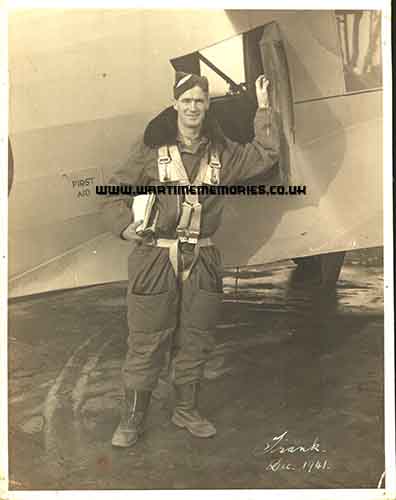F/Lt. Frank Seddon DFC.
Royal Australian Air Force 259 Squadron
from:Pigick, Victoria, Australia
Frank Seddon was a navigator, who enlisted in the RAAF in May 1941, aged 32. He trained in Canada through the Empire Air Training Scheme and was commissioned in March 1942. He was attached to Ferry Command in Montreal for three months before arriving in the UK in June 1942. He completed his training in Blackpool, Invergordon and Stranraer and was posted to 259 Squadron RAF in February 1943. The official histories say that the Squadron was reformed (for the first time in WW2) in February 1943 as a Catalina equipped general reconnaissance unit at Kipevu in Kenya. However, the Squadron flew its Catalinas from the UK, via Gibraltar, to Kenya.
Frank's crew was made up of personnel from throughout the Commonwealth - a South African captain, English second pilot, Scottish engineer and so on. The squadron's main duty was anti-submarine patrols over the Indian Ocean. Detachments also operated from sites in Natal and Cape Province, South Africa, and later moved to Dar-es-Salaam. Operations were also conducted from Madagascar and Mauritius and the crew took a visiting dignitary on a tour of bases in the Indian Ocean, including the Indian mainland. Frank was posted to Australia in July 1944 and expected to go to the Pacific. However, he was diagnosed as medically unfit (he had severe dermatitis) so served in training roles in Australia, including at Rathmines (NSW), until July 1945.
Frank, with his captain Acting Flight Lieutenant Bob Dutton, received the DFC for a mission described in the London Gazette of 14 April 1944: "These officers were captain and navigator respectively of an aircraft on reconnaissance patrol which sighted an enemy blockade runner or supply ship. In spite of adverse weather the ship was shadowed, until it was known that naval forces were approaching. Afterwards, Flight Lieutenant Dutton and Flying Officer Seddon made contact with these forces and guided them to the operational zone and the enemy vessel was subsequently attacked and destroyed. On this difficult and arduous sortie these officers displayed a high degree of skill and fortitude and their efforts contributed in a large measure to the success obtained. They have completed very many sorties and have displayed outstanding devotion to duty."
Frank had three close mates from around Rochester, Victoria, with whom he joined up ('The Four Horsemen of the Apocalyse', as they were known, though he said afterwards that they had no real understanding of the implications of that name!). The others also became airmen and served in the same crew in 461 Squadron RAAF, flying out of Milford Haven, Wales. They were all lost together when their aircraft was shot down.
Despite this tragedy, which he felt very strongly, Frank had a fund of funny stories about the war. These included arriving by ship in San Francisco and travelling by train to Canada under a cargo manifest, because the USA was still neutral at that stage and not supposed to be aiding the Allied war effort. Other stories were of one of their instructors in Canada describing the plane they were about to train on as '6500 bolts flying in close formation' and the travails of trying to get his mate Jimmy to pass a bomb aiming course, so he wasn't condemned to being a tail gunner. Frank also recounted - with not-quite mock indignation - the award of a (cardboard) medal from his squadron mates 'for not getting lost more than once' between UK and Gibraltar, when his crew (alone in the Squadron) hadn't got lost at all. While in Gib, one Cat had engine trouble and after waiting weeks for a replacement, they gave up and approached the Americans, who immediately said: 'Of course you can have an engine - how many do you want?' In Africa, there was a disappointment when all the wonderful photos of landscapes and large wild animals taken on the way down (on film he wasn't supposed to have) failed to develop. He'd been given film that was way beyond its use-by date. There were also the usual tales of returned servicemen about weevils in the 'hard tack' biscuits, and their wives' complaints about how long it took them to remember that they no longer had a batman to pick up after them. One much sadder story, which I think came from India, was about an officer who sat all day in the mess 'knitting Spitfires' to replace those lost in the Battle of Britain.
At some point after his return to Australia from Africa, Frank was billeted at the famous Melbourne Cricket Ground (MCG). The servicemen slept in the open stands and found it a very uncomfortable place to be in a Melbourne winter. The old stand - complete with scratched initials from hundreds of men billeted there throughout the war - was demolished a decade or so ago for the construction of the Great Southern Stand.
About 30 years after the war, Frank and his wife Effie reunited with 'Spider' Davis, the second pilot, who visited Australia on holidays and was visited in turn in England. (Spider told Frank's daughter that he was convinced that her father was the only reason they were all still alive, because of number of times he'd navigated them back to tiny islands after 20 hour patrols over the Indian Ocean. Frank later taught his son-in-law the Francis Chichester technique of making a deliberate error in one direction, so that when you've run down your dead reckoning, you know which way to turn to search for your destination.) Frank and Effie also caught up with the crew's engineer Charlie Hamill and his family in Glasgow and went in search of another crew member in Lewis. They got as far as Stornaway before discovering that his mate had died there only 3 months before.
